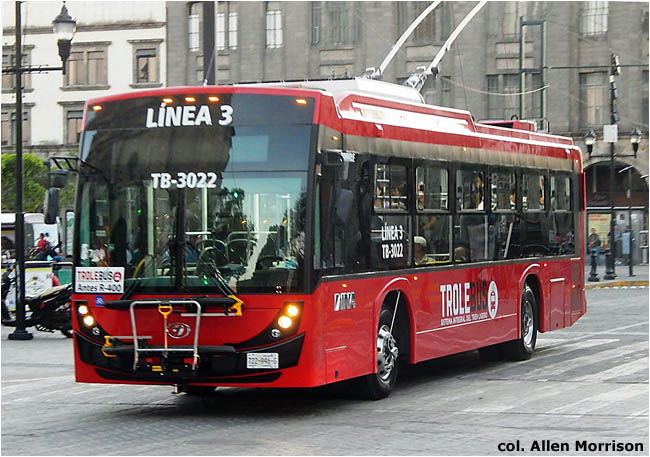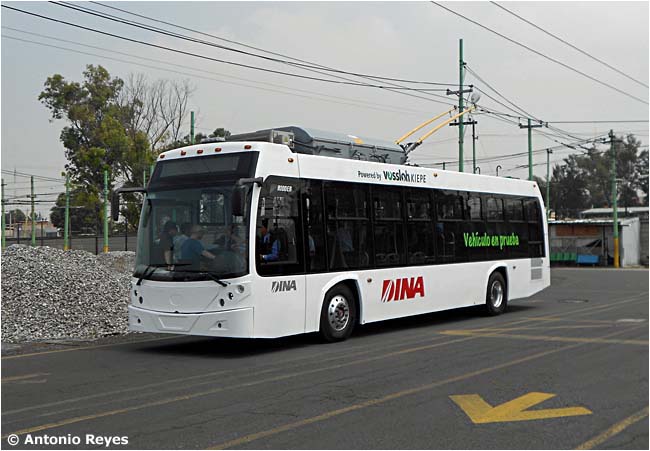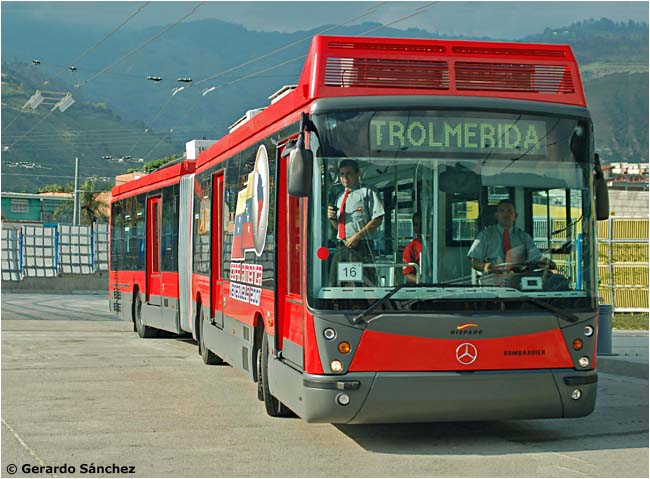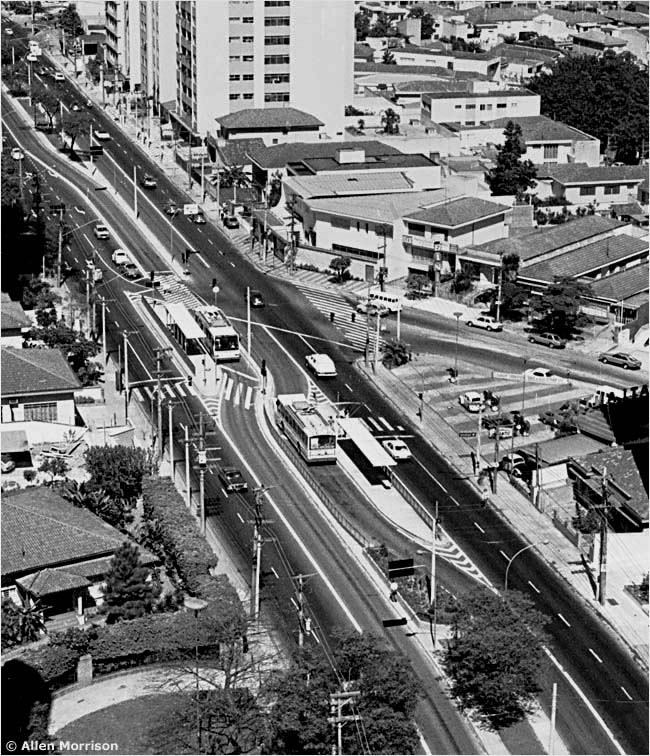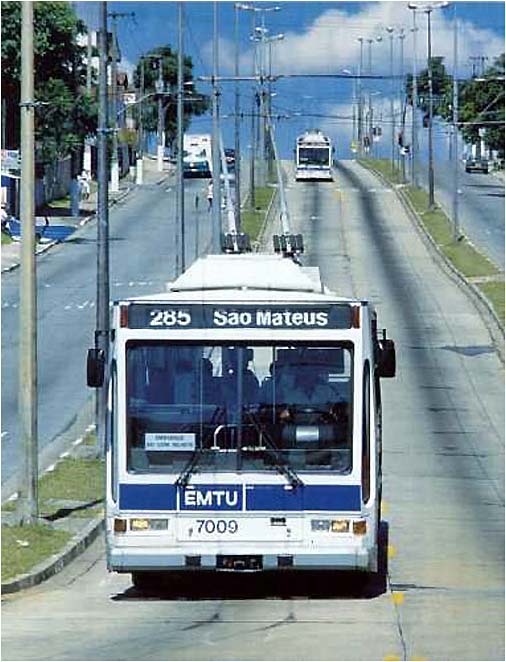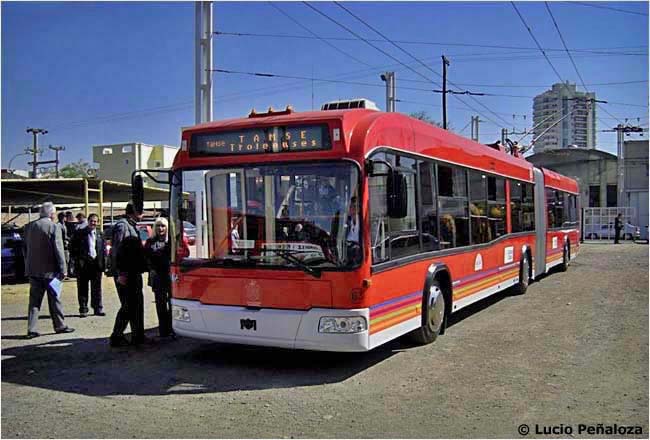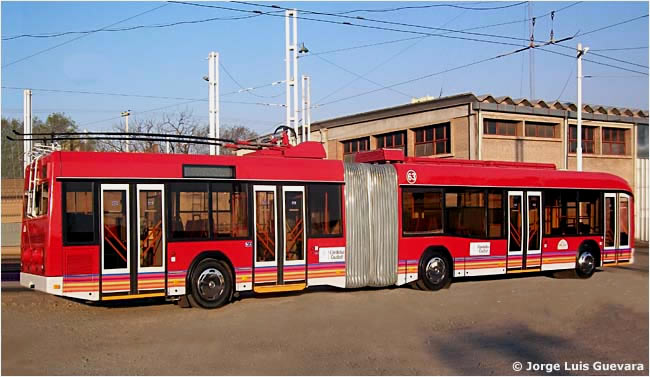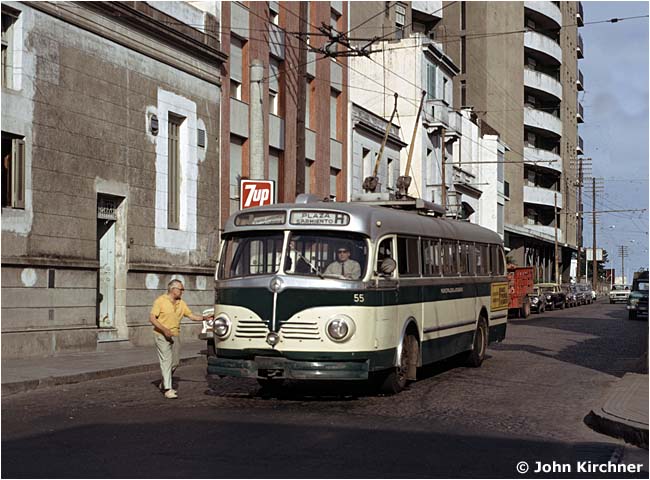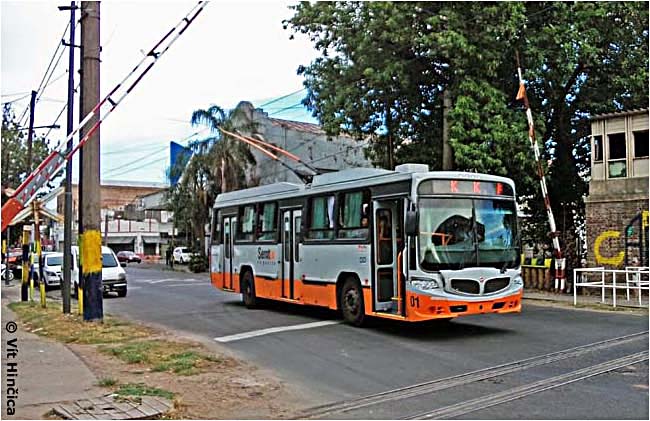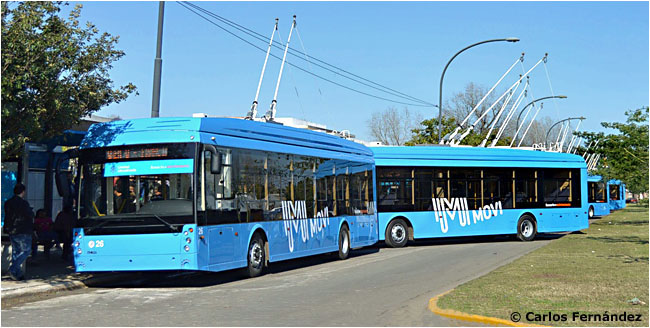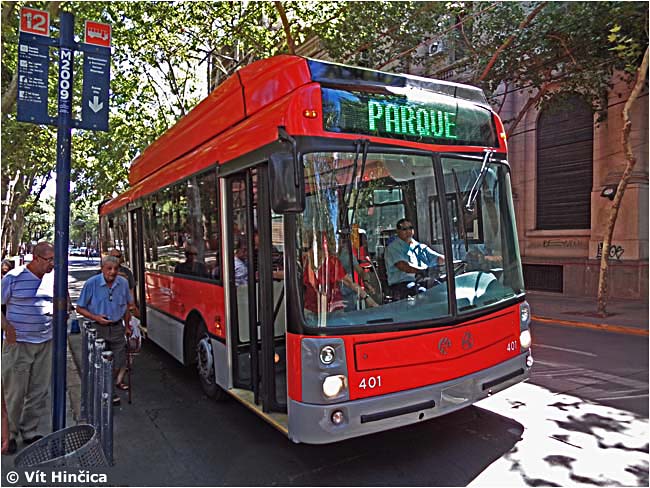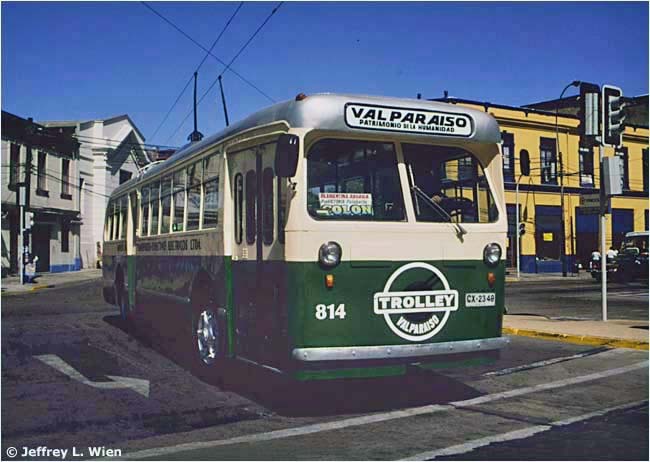THE TROLLEYBUSES OF
LATIN AMERICA
in 2017
Allen Morrison
Trolleybuses have carried passengers in 35 cities in Latin America since 1913 (see list). They operate in 10 cities in 2017 (from north to south): GUADALAJARA and MEXICO CITY in Mexico; MÉRIDA in Venezuela; QUITO in Ecuador; SÃO PAULO and SANTOS in Brazil; CÓRDOBA, ROSARIO and MENDOZA in Argentina; and VALPARAÍSO in Chile. The systems in Mexico City and São Paulo are among the oldest and largest in the Americas; São Paulo actually has two systems. Five of the other cities have only one trolleybus line, but the Mérida and Quito lines are quite long, run in segregated lanes and are the most modern. (A similar line was planned in Barquisimeto, Venezuela...) Here is a brief survey, from north to south, of the 11 systems in 10 cities, with pictures and links to maps and other pages that describe them in detail. More material is presented for places like Guadalajara for which not much other information is available. This page is basically an update to surveys and articles published in the U.S. periodicals Trolley Coach News between 1977 and 1985 and Traction Yearbook '87 in 1987: see BIBLIOGRAPHY, below. As noted in the text, recent information was found in articles and news items published in the English Trolleybus Magazine.
_____________
GUADALAJARA The trolleybus system in Guadalajara had an unusual origin and for a while had a very unusual feature. The city's tramway system closed in 1944 and autobuses provided local transport for the next 32 years. The Jalisco state government built a 5-km subway under Av. Federalismo in the 1970s, but because of cost overruns could not afford to buy the trains. So it decided to run trolleybuses through the tunnel instead and purchased 125 Marmon-Herrington vehicles secondhand from Chicago. There were five stations in the tunnel, and at the portals the line came onto the surface and formed an X-shaped network [see 1976 map]. The first service, from Plaza del Sol to Panteón Nuevo, began carrying passengers on 15 December 1976. In 1982 the operator, SISTECOZOME (Sistema de Transporte Colectivo de la Zona Metropolitana), expanded the fleet with new trolleybuses built locally by MASA (Cia. Mexicana de Autobuses S.A.). Later that year, in order to extend the tunnel south, it temporarily closed its southern end and for a while the trolleybuses were reversed inside the tunnel on a turntable. This extraordinary procedure was photographed by a visitor from Massachusetts on 22 August 1982 [Foster M. Palmer]:
In 1985, when the subway was extended north, the turntable was relocated and the procedure was repeated. Finally, in late 1987 or early 1988, the trolleybus line was removed from the tunnel and a rail line was built in its place. The trolleybus lines on the south side of town remained isolated for a while, then closed. SISTECOZOME built new routes in the 1980s, purchased 18 articulated trolleybuses secondhand from Mexico City in 1994, and opened an impressive new 15-km trolleybus line along Calzada Independencia, which it numbered 600, in 1995 [see 1995 map]. Unfortunately, a trolleybus shortage caused its demise in 2005. Electric buses continued to operate only on routes 200, 400 and 500 in 2006. The photograph below shows route 500 in August 2007 [John Kirchner]:
Line 200 discontinued electric operation in August 2008, and the following March the city's first diesel-powered bus rapid transit ("BRT") service opened along Calzada Independencia, the former path of trolleybus route 600 [see 1995 map]. This 2010 map shows what remains of Guadalajara's trolleybus system today. The picture below, taken on Av. Vallarta in July 2009, shows what most of the vehicles look like [John Kirchner]:
All three trolleybuses shown in this chapter are the same MASA model built in 1982-1985. The SISTECOZOME website provides individual maps of routes 400 and 500 [north is on the left side of both maps]. The Siteur website describes the rail line. My webpage about The Tramways of Guadalajara shows the earlier streetcar system – and two trolleybus views. Tom's North American Trolley Bus site shows dozens of Guadalajara trolleybuses [explore links in left column]. One can find recent pictures of Guadalajara trolleybuses via the "street view" mechanism of Google Maps: here is a sample on Calzada del Obrero [after the image opens, click the double arrows by the compass to enlarge]. In this view of Calle Independencia, trolleybus 1181 has just passed parked 1164, which still wears the previous livery. The images can be enlarged several times. On
31 January 2015 SISTECOZOME closed the Guadalajara trolleybus system.
No trolleybuses ran in Guadalajara for almost a year. On 29 January
2016 the trolleybus system was transferred to SITREN, the bus division
of SITEUR, the city's metro operator, which on 2 February reopened
route 400 – relabeled "Línea 3" – with a new
fleet of 25 Dina/Skoda trolleybuses constructed in Mexico. Note bike rack on front [col. AM]:
Much of the data in this text was culled from the articles about Guadalajara trolleybuses by Steve Morgan and Gert Aberson in Trolleybus Magazine #173 of 9-10/1990, #190 of 7-8/1993, #208 of 7-8/1996 and #209 of 9-10/1996. The 1995 map linked on this page comes from #208.
_____________
MEXICO CITY The trolleybus system in Mexico City opened 25 years before the first lines in Guadalajara, is much larger and has operated many more vehicles. Its development was more conventional, but Mexico City's transit system also had a unique feature: the largest fleet of secondhand vehicles of any transit system in the world. Servicio de Transportes Eléctricos ("STE"), which also ran the city's tramway system, ordered 20 trolleybuses from Westram in the U.S. in 1947 and opened a trackless line from Indianilla depot to Tacuba on 9 March 1951 (part of the route still operates today as line "I": see 2002 map). STE purchased 40 trolleybuses from the Italian builder Alfa-Romeo in 1952-1953, but thereafter no new vehicles for 22 years. Between 1947 and 1987 STE imported 390 trams and 813 trolleybuses secondhand from 19 transit systems in the U.S. and Canada. The trolleybuses came from Birmingham, Denver, Cleveland, Milwaukee, Dallas, Shreveport, St. Joseph, Los Angeles, New Orleans, Montreal, Johnstown, Winnipeg, San Francisco and Edmonton. Mexico City became a giant "operating trolleybus museum" for U.S. and Canadian trolleybus fans. The trolleybus system was designed to supplement the tram system, but eventually replaced it. STE extended the Tacuba line to the airport and established a new trolleybus depot at San Juan de Aragón in 1952 [see map]. In 1954 it pushed the line west along Av. Cuitlahuac [today's route "G"] and created a long circular trolleybus line around the city center. It also built a long line on Av. Lázaro Cárdenas - Niño Perdido [today's route "A"] which pierced the city from north to south. Trams had never run there. In 1957 STE abandoned its Indianilla shops, established new tram and trolleybus facilities at Azcapotzalco and Tetepilco, and built a new tram line from Tetepilco to Mixcoac [which later became trolleybus route "D"]. Trolleybus substitutions continued in the 1960s and 70s and STE ran its last "PCC" car in 1979. In the 1980s it purchased 400 new trolleybuses from MASA (Cía. Mexicana de Autobuses S.A.) and had its current fleet rebuilt by MOYADA (Motores y Adaptaciones Automotrices). In 1989 it was operating about 700 trolleybuses on 30 lines with a route length of 557 km. It was the largest trolleybus system in Latin America [see 1993 map]. There are only 10 trolleybus lines running in Mexico City today [see 2002 map]. Poor management, ageing vehicles, metro construction and the development of "bus rapid transit" have taken a toll on the trolleybus system. Sistema de Transporte Colectivo ("STC") opened its first metro line in 1969 and today has a giant network of 11 lines with 163 stations, the second-largest in the Americas after New York. Some STC routes have replaced trolleybus lines. Metrobús opened its first reserved-lane route in 2005, a second in 2008, and now has four or five. Today only one trolleybus line, north-south route "A", penetrates the central area of the city – around Bellas Artes metro station [see map] – and the casual visitor might never know that Mexico City has a trolleybus system. The photograph below, taken in August 2007, shows a MASA trolleybus on STE route "G" on Eje 3 Norte (North Axis 3), an artery that crosses the north side of town. "M Rosario" in the window means that it's going to Rosario metro station. Route letters such as "A" and "G" are shown on STE maps, but usually not on its vehicles. STE has always had a peculiar indifference to good signage [John Kirchner]:
In 2009 STE rebuilt line "A" as a "Corredor Cero Emisiones" (Zero Emissions Corridor): the city's first 100% reserved-lane trolleybus line. One hundred twenty rebuilt MASA trolleybuses, with a new livery featuring the Ángel de la Independencia, were assigned to the rebuilt 18.3 km route [see map] and all other public transport vehicles were banned from those streets. This photograph was taken in August 2009, shortly after the service began [John Kirchner]:
In 2013 STE began testing a new low-floor trolleybus built by DINA (Diesel Nacional, S.A.) in Hidalgo state north of the capital. The vehicle was photographed on 17 June 2013 at Tetepilco depot at the east end of trolleybus line "D" [see map] [Antonio Reyes]:
A similar, newer DINA trolleybus was displayed at a transport fair in November 2013 and ran on the Guadalajara system in 2014. The Mexico City trolleybus system was one of the first in Latin America and is the second-oldest, after São Paulo, in operation today. Unlike the lines in São Paulo, which fan out from the city center, most of the lines in Mexico City operate outside the center as feeders to the metro. Many run in express highways called ejes viales (traffic axes). STE also operates a tren ligero (light rail line) between Tasqueña metro station and Xochimilco, the latest incarnation of the electric tram line that opened in 1910 and recently celebrated its centenary [route "L1" on the map]. The STE website provides an illustrated 2-page history of trolleybus development and a description of the current fleet. It also includes a list of trolleybus lines (unfortunately not up to date) and an enlargeable (and awkward) system map. Tom's North American Trolley Bus site displays hundreds of pictures of Mexico City trolleybuses, in every period, and a roster. By exploring the "street view" feature of Google Maps one can find many more views, such as this one, which shows what happens when a truck blocks the trolleybus lane [after the image opens, click the double arrows by the compass to enlarge]. Here is another. Much of the data in this text was culled from articles about Mexico City trolleybuses by Steve Morgan and Gert Aberson that appeared in Trolleybus Magazine #174-5-6 (11/1990-4/1991) and #191-2 (9-12/1993). Steve Morgan also published an illustrated article about "Trolley Buses in Mexico" in the Winter 1995-1996 issue of Bus World. St.-Petersburg Tram Collection in Russia once sold a model of a Mexico City ex-Winnipeg Brill trolleybus, but it is difficult to obtain today.
_____________
MÉRIDA This small Venezuelan city, on a plateau high in the Andes, was never reached by intercity railroad and never had a street railway of any kind. Its 11-km trolleybus line was the newest and most modern in the Americas and one of the most extraordinary anywhere. It was a genuine interurban trolleybus line, connecting Mérida with the neighboring city of Ejido, with open country and mountains in between [see map]. The terminal in Ejido was spectacular. The line was modeled on the line in Quito and the 45 articulated trolleybuses operated left-hand, entirely in reservation, in counterflow to right-hand traffic. Trolmérida's trolleybuses started carrying passengers in 2006, but the company did not charge fares until 2014. Number 16 in this photograph was using its diesel motor in the depot area [Gerardo Sánchez]:
The line's operation was transferred in August 2009 to a new government agency, Trolebús Mérida, C.A. (TROMERCA). The latter began replacing trolleybuses with Chinese diesel buses in 2015 and had replaced most of them by August 2016. Trolleybuses still run occasionally in diesel mode, but the system has basically been de-electrified. My webpage about The Trolleybuses of Mérida contains a detailed history of this wonderful line's rise and tragic fall, with a map and 29 illustrations. Construction began in 2005 of a similar trolleybus line in Barquisimeto, Venezuela. A new company, TRANSBARCA, ordered 80 articulated trolleybuses from Neoplan in Pilsting, Germany. The vehicles arrived in 2007-2009, but sat unused in a field near the airport until December 2012, when a few of them began providing free rides on a limited schedule. However, TRANSBARCA was liquidated in February 2013 and trolleybuses have not run since that time. Overhead wire remains along Avenidas Libertador and Florencio Jiménez, but the fate of the Neoplan vehicles is unknown.
_____________
QUITO A fleet of 113 articulated trolleybuses carries a quarter million passengers a day on a single 19 km line in Ecuador's capital. When it opened in 1995 it was one of the first examples of trolleybus rapid transit in the world (preceded only by operations in São Paulo, Brazil). An extension that opened in 2000 was the first line where trolleybuses ran left-hand, against other traffic [see map]. El Trole's phenomenal success, intelligent design and general appeal attracted transport planners worldwide and inspired bus rapid transit projects in Bogotá in 2000, Santiago and Mexico City in 2005, Guayaquil in 2006, Guatemala City in 2007 – and trolleybus rapid transit projects in Mérida and Barquisimeto, Venezuela. This photograph shows one of the Spanish-built vehicles turning into Estación La Y, at the north end of the line [Steve Morgan]:
The left-hand operation did not work out. Trolleybuses ran against traffic in the 7.5 km section south of El Recreo because they have doors on only one side and the stations there were built between the trolleybus lanes, rather than on each side. The arrangement caused confusion and accidents and "Trolesur" was de-electrified in 2016. Since that time the extension has been operated exclusively by diesel buses that have doors on both sides. All stations along the trolleybus route have recently been lengthened to accommodate two trolleybuses at once, and also to accommodate new double-articulated diesel buses that, alas, now share the trolleybus route. My 3-page website about The Trolleybuses of Quito describes the line in detail and contains 62 illustrations and a map.
_____________
SÃO PAULO The largest and most populous city on the South American continent also has its largest trolleybus system. The Brazilian metropolis has, in fact, two trolleybus systems. Its tramway operator, Companhia Municipal de Transportes Coletivos, opened the first line on 22 April 1949 with 30 trolleybuses imported from England and the United States: 4 from British United Traction, 6 from Pullman and 20 from Westram (identical to those in Mexico City). The system expanded rapidly and 125 more trolleybuses arrived in the 1950s: 50 from Uerdingen in Germany and 75 ACF-Brills purchased second-hand from the transit system in Denver, Colorado. Several companies in Brazil began building trolleybuses in the 1950s and no more vehicles were acquired from abroad. CMTC ran its last tram in 1968. Companhia Metropolitano de São Paulo opened its first metro line in 1974. My Trolefolia page contains 45 photographs of São Paulo trolleybuses taken between 1975 and 1980, including views of the pioneer Vila Prudente line displayed in the aerial photograph below. The city of Curitiba in nearby Paraná state inaugurated the world's first reserved-lane bus line in 1974. São Paulo responded with the world's first reserved-lane trolleybus line. Commercial service began 7 April 1980 on 7 km route 3160 between Praça da Sé and Vila Prudente [see map]. The aerial view below of Av. Paes de Barros was taken the following month [AM]:
CMTC created more reserved-lane trolleybus lines in the 1980s, notably a 15 km route with four pairs of wires, for local and express service, to Santo Amaro [see map]. By the mid-1980s CMTC was operating almost 500 trolleybuses on 22 routes [see crudely colored schematic map]. On 3 December 1988 a new state agency, Empresa Metropolitana de Transportes Urbanos (EMTU), inaugurated the first section of a new reserved-lane trolleybus system in the "ABD" suburbs – Santo André, São Bernardo and Diadema – south of São Paulo city. Its first 30 trolleybuses were built by Companhia Brasileira de Materiais Ferroviários (COBRASMA) [photo: Associação Nacional dos Transportes Públicos]:
The CMTC urban lines were absorbed in 1994 by a new municipal agency, São Paulo Transporte [SPTrans], which divided the network among three new companies based on region. The vehicles acquired new liveries and fleet numbers. EMTU, in turn, created a subsidiary in 1997, Metra Sistema Metropolitano de Transporte, to operate its trolleybus network south of the capital. In that same year the city began construction of an extraordinary new project: a pair of elevated bus lanes over Av. del Estado southeast of downtown [see map] on which double-articulated trolleybuses would be guided by tiny side wheels. The first tests of São Paulo's veículo leve sobre pneus (VLP) (light vehicle on tires), nicknamed "Fura-Fila", took place along a 2.8 km section in September 2000 [Sergio Martire]:
My Fura-Fila page has more information and pictures. Alas, a new mayor elected in 2001 scrapped the VLP project and also most of the trolleybus lines on the city's north and west sides: the four Santana lines, Casa Verde, and all the routes down Avs. Augusta and 9 de Julho, including the showpiece Santo Amaro line [see map]. Only route 408A and trolleybus lines on the city's east side survived. A new company called Himalaia Transportes was formed in 2005 to operate the 14 remaining routes. This ex-Denver Brill, built in 1948 and preserved at the city's Museu dos Transportes, joined a trolleybus parade in January 2006 [Sergi Martire]:
São Paulo's urban trolleybus system, the oldest in Latin America, celebrated its 60th birthday in April 2009. The following photograph, taken in December 2009, shows two "Piso Baixo Total" (100% Low Floor) specimens built in 2008 by Busscar Ônibus and Weg Indústrias in Brazil [John Kirchner]:
The urban system was transferred again in 2011 to Ambiental Transportes, which operates it today. In the last few years Ambiental has replaced its entire fleet with 201 new trolleybuses built in Brazil. This 3-axle 15-meter-long Scania Millennium was photographed on Rua Figueira near Parque Dom Pedro terminal [see map]. It has doors on both sides [Samuel Tuzi]:
Metra, today, operates an assortment of 2- and 3-axle articulated vehicles on its ever-expanding system. This CAIO/Eletra Millennium "BRT" trolleybus was photographed in 2014 on Av. Engenheiro Armando near Jabaquara Terminal at the end of metro line 1 [see Metra map] [Samuel Tuzi]:
The São Paulo section of the Trólebus Brasileiros website by Marco Antonio Gagliano Brandemarte contains more material about the urban system (including pictures copied from my Trolefolia page). Its Região Metropolitana section describes the suburban Metra network. The Metra website includes a system map and pictures of its fleet! (In addition to trolleybuses, Metra also operates diesel, ethanol, hybrid and hydrogen buses.) Some of the data on this page originated in my 12-page article, "São Paulo in Transition", published in Trolleybus Magazine (England) #114 of September 1980. St.-Petersburg Tram Collection in Russia sells a model of São Paulo's ex-Denver Brill trolleybus, but it seems that the Pullman model is no longer available.
_____________
SANTOS The Brazilian port was the last of six cities in Latin America to purchase trolleybuses made by Fiat/Alfa-Romeo in Italy (Mexico City, Montevideo, Salvador, Rosario and Rio de Janeiro acquired them earlier, in that order). Here is an illustration from a Fiat brochure which shows the model that it built for Serviço Municipal de Transportes Coletivos [SMTC] in Santos:
Five Fiat trolleybuses arrived in Santos in June 1963 and inaugurated the city's first line the following August. Another 45 arrived that year and SMTC soon had five trolleybus lines running between Praça Mauá near the docks and the beaches along the Atlantic Ocean [the map shows the five original routes – 4, 5, 8, 40 and 53 – as dotted lines; the solid line is route 20 built later]. The Santos tramway system, the last in Brazil, closed in 1971. My Trolefolia page contains 22 photographs of Santos trolleybuses taken in January 1975. SMTC was reorganized as Companhia Santista de Transportes Coletivos [CSTC] in March 1976. The 50 Italian trolleybuses provided the backbone of the city's transportation system for the next 20 years. CSTC acquired a dozen new trolleybuses in the 1980s from local firms, Marcopolo and Mafersa, and opened a new line along Av. Ana Costa, which it numbered 20, in 1988. It discarded the Fiats and all but one of its Marcopolos in 1996 and de-electrified all its routes except 20, which was transferred to a new company, Viação Piracicabana, in 1998. One of the Fiat trolleybuses was dieselized and rebuilt as a "Biblioteca Volante" (Mobile Library) in 1999. It awaits restoration today in a garage. At present Piracicabana operates route 20 with a mixed fleet of Mafersa trolleybuses and diesels. The photograph below shows a Mafersa on a one-way street in the port area in January 2007 [Antonio Gorni]:
The webpage Trólebus de Santos by Emílio Pechini contains a history and 40+ illustrations of Santos trolleybuses, as well as links to the author's videos. "The Trolleybuses of Santos" by Jorge Françozo de Moraes, published in Trolleybus Magazine #120 of September 1981, contains photos, a map and information about early trolleybus development. My map of the city's heritage tramway shows the trolleybus route that still runs today. My website about The Tramways of Santos describes the original rail system.
_____________
CÓRDOBA Argentina's second most populous city was, oddly, its only large city that did not receive some of the 700 trolleybuses that the Argentine government purchased from Germany in 1952 [see sections on Rosario and Mendoza, below]. The Córdoba trolleybus system opened in 1989, more than two decades after the trolleybus systems in many Argentine cities had run their course and closed. The Municipalidad purchased ten 2-axle ZiU trolleybuses from Uritsky in the U.S.S.R. in 1988 and Expreso Emir, a local trucking firm, opened part of route "B", the first of Córdoba's three planned trolleybus lines [see map], on 7 May 1989. Another 22 2-axle trolleybuses and 12 3-axle articulated models arrived from Uritsky soon after. By 1992 44 Soviet trolleybuses were operating all three routes. Here is Expreso Emir 32 in 1991 [Michael Roschlau]:
Córdoba was the last of four cities in Latin America to purchase ZiU trolleyuses from the U.S.S.R.: Bogotá (Colombia) acquired them in 1967, Rosario in 1979 and Mendoza in 1984 [see below]. Córdoba trolleybus operation was transferred in 1993 to Transportes Eléctricos Cañadense, in 1996 to the Municipalidad de Córdoba, and in 1997 to a new company called Trolecor S.A., which promised to import 50 new Norinco trolleybuses from China. Trolecor imported only 16, which arrived in 2000. This page has six photographs of both the Soviet and Chinese units and a chronology up to the year 2000. This one has six photos and a 2000 map, one of the photos dated 2004. The lower 2/3 of this Buses Urbanos page contains historical notes and 20 enlargeable photographs taken in 2007. Here is one of its views of Norinco 47 [Hugo González]:
Transporte Automotor Municipal Sociedad del Estado ["TAMSE"] acquired the trolleybus system in 2004 and is its fifth operator in 15 years. This photograph of a restored ZiU was taken in 2008 [Lucio Peñaloza]:
In 2009 TAMSE purchased five discarded 2-axle ZiUs from the Mendoza system [see below] and contracted the firm Plegacor to renovate its articulated models. Here is the interior of renovated ZiU articulated trolleybus 31 [Lucio Peñaloza]:
In 2010 TAMSE acquired an articulated trolleybus on loan from the Belarusian manufacturer Belkommunmash ["BKM"] in Minsk. The vehicle arrived in Argentina in July and was presented to the Córdoba press on 7 September [below]. If TAMSE approves its performance, it has an option to purchase 10 [Lucio Peñaloza]:
Here is a door-side view of Córdoba's new BKM trolleybus, provisionally numbered 63 [Jorge Luis Guevara]:
In
2014 TAMSE ordered seven new trolleybuses from Trolza (ex-Uritsky) in
Russia: five "Optima" models and two "Megapolis" models. The latter
have auxiliary battery power. The vehicles arrived in 2015 and began
carrying passengers in Córdoba on 5 February 2016. The
photograph below shows an Optima model on 3 February [Lucio Peñaloza]:
In 2017 TAMSE operated 41 trolleybuses: 33 ZiU, 7 Uritsky, and the single BKM. The Norinco trolleybuses are out of service. The TAMSE website provides an amusing system map with animated trolleybuses (select "Trolebuses", then route). Trolleybus Magazine (UK) has never published a feature article on Córdoba, but there is a 1994 route map on page 73 of issue #201 (May-June 1995). At one time St.-Petersburg Tram Collection in Russia produced models of both the 2-axle and 3-axle ZiUs built for Córdoba; but both seem now to be out of production. A special aspect of trolleybus operation in Córdoba is the fact that all the vehicles are driven by women.
_____________
ROSARIO In 1952 the Argentine government imported 700 new trolleybuses from Germany – 350 Mercedes-Benz, 175 Henschel and 175 from Maschinenfabrik Augsburg Nürnberg [MAN]. Most of the vehicles ran in the capital, Buenos Aires, but about 110 were sent to provincial cities: Bahía Blanca, La Plata, Tucumán, Mar del Plata and Rosario. Ten MAN trolleybuses inaugurated the Rosario system on 24 May 1959. Later in 1959 Mendoza purchased 40 trolleybuses from Fiat/Alfa Romeo in Italy, of the same type acquired later by Santos [see above]. The system soon expanded to seven routes, but in September 1969 eleven trolleybuses were set afire and another 14 heavily damaged in a protest movement called the Rosariazo. The following year, to help restore its fleet, Rosario acquired 25 second-hand Mercedes-Benz trolleybuses from Buenos Aires and Mendoza. Number 55, below, was photographed in November 1972 [John Kirchner]:
In 1982 EMF constructed three battery-powered vehicles which it called electrobuses. All carried passengers on an experimental basis on route 'M', and one was later converted to a trolleybus. But route 'M' closed in 1984, and only route 'K' operated trolleybuses in Rosario for the next eight years. In 1992 the municipality decided that EMF was not providing adequate service so cancelled its franchise, and trolleybus operation ceased (temporarily) at the end of that year. In 1993 a new contract was signed with a new organization called ECO-BUS, which purchased 20 Marcopolo/Volvo trolleybuses that had been built in 1987 for a system in Belo Horizonte, Brazil, that never ran. The vehicles arrived in 1993 and reopened route 'K' on 25 January 1994. The photograph below was taken three months later. These are the only Brazilian-built trolleybuses ever to run outside Brazil [AM]:
Operation
passed in 2004 to the Sociedad del Estado Municipal para el Transporte
Urbano de Rosario [SEMTUR], which has operated the line ever since. In
2011 SEMTUR contracted a local bodyworks named ArMar Carrocerías
to reconstruct its fleet. All the Brazilian trolleybuses except number
08 - preserved for historical purposes - were rebuilt. A Czech visitor
photographed number 01 on 21 January 2014 [Vít Hincika]:
But the Marcopolo/Volvo fleet was ageing. In 2017 SEMTUR imported 12 "Megapolis" model trolleybuses from Trolza in Engels, Russia. The photo below was taken during the presentation of the new fleet on 13 July 2017. The following day they joined the Marcopolo fleet for service on route 'K' and, since they were equipped for battery operation, also inaugurated new unwired route 'Q' on Av. Francia [Carlos Fernández]:
Buses Rosarinos, a local enthusiast group, has several fine pages online, including a celebration of 50 años de trolebuses en Rosario by Adrián Yodice, which presents a complete history of the system. Another page describes each trolleybus model in detail. Trolleybus enthusiast Mariano Antenore, who published a history of Rosario trolleybuses in book form, has a trolleybus blog which includes a map of line 'K'. Trolleybus specialist Steve Morgan published an 8-page article about the Rosario trolleybus system, with a map and seven pictures, in Trolleybus Magazine #150 of November-December 1986, and supplied two photographs and an updated version of the map, showing a new extension, to TM #200 of March-April 1995. A few more pictures can be found here.
_____________
MENDOZA The capital of Mendoza province, Argentina, had the first trolleybus operation in Latin America and one of the first in the world. South American Railless Traction Co., organized in London in 1912, planned to cover the continent with trolleybus lines and built an experimental route in Mendoza in 1913. (It was the only line that it built.) The Mendoza vehicle, built by the Cedes Stoll Co. in Leeds, allegedly ran for two years, but no photograph of the operation has been found. The picture below shows the Mendoza unit testing in England before it was shipped to Argentina [col. AM]:
Mendocinos had to wait 43 years to ride a trolleybus again. The city's "second" trolleybus system was inaugurated with 20 Mercedes-Benz vehicles that had been sent to Bahía Blanca in 1954 [see Rosario, above], but which that city never used. They were transferred to Mendoza and the Empresa Provincial de Transportes de Mendoza [EPTM] opened the first line of its new trolleybus system on 14 February 1958. The system prospered and in 1962 EPTM purchased 36 Nissan/Toshiba trolleybuses from Japan, which were the only Japanese trolleybuses ever to run in regular service outside Japan. Number 122 was photographed by an Australian enthusiast in December 1974 [Barry Blumstein]:
In 1984, in exchange for wine, EPTM acquired 17 ZiU 2-axle trolleybuses from the U.S.S.R. and in 1988 it purchased 78 used Krupp/Kiepe trolleybuses (built 1968-1974) from the system in Solingen, Germany. (21 of them were acquired only for parts.) These were the only 3-axle non-articulated trolleybuses in Latin America. Number 5 was photographed on the Dorrego route in January 2010 [Jorge Luis Guevara]:
Following Japanese, Russian and two groups of German trolleybuses, EPTM purchased 80 Flyer trolleybuses secondhand from Vancouver, Canada, in 2008. They had been built in Winnipeg in the early 1980s. The photograph below shows one of them on the Las Heras - Godoy Cruz line in December 2009. Apparently it is equipped with a wheelchair lift [Jorge Luis Guevara]:
EPTM sold five of its discarded ZiUs to Córdoba in 2009 and acquired a new trolleybus, number 401, built by Materfer in Argentina, in early 2013. It has been in service since June of that year. The photograph below was taken by a Czech visitor in January 2014:
The "Trolebuses Mendocinos" blog of Jorge Luis Guevara has voluminous data, news, photos and video links. A "Colectivos de Mendoza" page presents a nice illustrated history of the system and more than 180 photographs of trolleyuses, most of them in Mendoza. There are 34 pictures of the Solingen trolleybuses before they left Solingen. Trolebusista Steve Morgan published a 6-page survey of the Mendoza trolleybus system, with a map and five illustrations, in Trolleybus Magazine #153 of May-June 1987; and another article, with photographs and large, updated maps, in TM #291 of May-June 2010.
_____________
VALPARAÍSO The trolleybus system in the Chilean seaport is famous for operating the oldest trolleybuses in the world, which were accorded National Monument status by the Chilean government on 3 July 2003 [see Consejo de Monumentos Nacionales]. The 15 trolleybuses in question were built by Pullman Standard Co. in Massachusetts in the period 1946-1952, some for Valparaíso and others for the system that formerly operated in Santiago, the Chilean capital. One of them, number 814, built in 1947, is the world's oldest trolleybus still in original form and still in regular service (other trolleybuses are older, but have been altered). Here it is, photographed on Avenida Argentina in Valparaíso, in December 2003 [Jeffrey L. Wien]:
The
Valparaíso system also operates Chinese trolleybuses and other
models, including articulated trolleybuses, imported secondhand from
Switzerland. It recently purchased 10 trolleybuses from the
operator in Luzern, Switzerland, which were placed in service in March
2015 [Samuel Fuentes]:
The operator, Trolebuses de Chile, has an elaborate website with an animated trolleybus, an animated "Ruta" map (upside down), a slide show of its 18 Pullman liveries ("Nuestros Troles") and, under "Historia > Archivo de Prensa", an impressive collection of newspaper articles about trolleybuses going back 70 years. The Valparaíso provincial government supplies a nice PDF map which shows the trolleybus line and also the city's 14 funiculars and underground Polanco elevator. The trilingual website Trolleybus Valparaiso of Samuel Fuentes contains an extraordinary collection of enlargeable photographs of trolleybuses of every model, inside and out, from every period [choose Spanish, French or English text under the main title]. My 2-part website about The Trolleybuses of Valparaíso [also available with Spanish text] presents a detailed history, all-time map and 50 historic illustrations. The webpage Trolejbusy ve Valparaísu has text in Czech and 45 enlargeable photographs. At one time St.-Petersburg Tram Collection in Russia sold a 1:43 scale model of trolleybus 814, but it is now out of production.
_____________
BIBLIOGRAPHY Traction Yearbook '87. Joseph P. Saitta, ed. Merrick, NY (U.S.), 1987 [1992]. Two articles on Latin American transport: "Twin Poles in South America" by Steve Morgan, pp. 106-117, describes the trolleybus operations on the continent in 1986. "Down Mexico Way" by Joseph P. Saitta, pp. 118-128, describes the tramway and trolleybus operations that year in Mexico City and Guadalajara. Each article is accompanied by 30+ high-quality color photographs. Trolleybus Magazine. London area (U.K.), 1965-present. The world's foremost periodical about trolleybuses. Feature articles, photos, maps and news items. Some of the material about Latin American trolleybuses is credited in the chapters above. World Trolleybus Encyclopaedia by Alan Murray. Reading (U.K.), 2000. A brief survey of trolleybus development in Mexico, the Caribbean and South America, pp. 47-51. A chart showing opening and closing dates, number of vehicles, route length, etc., of systems in these areas, pp. 78-81.
------------------------------------------------
See my index of If you have comments, criticism or suggestions, This first version of this page Copyright © 2010-2110 Allen Morrison |



